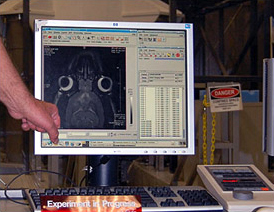
The image of a rodent brain made with the lab's 900 MHz NMR magnet.
MRI stands for magnetic resonance imaging, and it's one of the premier techniques used in radiology in order to look inside the body. What's nice about MRI is it gives you a complete 3D picture. Things like X-ray or CT are very good at looking at solid matter, like bones, in particular. MRI is very good at giving soft tissue contrast, soft tissue being muscles, brain, tendons.
In most cases you're looking at the protons in water. That water is in different environments, dependent on whether the tissue is a muscle or brain or different parts of brain or even possibly a tumor. Therefore, those protons experience a slightly different magnetic field, and that gives us the ability to tell the difference between the brain and a cancerous tumor.
Another nice feature of MRI is that it has no ionizing energy. It does not cause damage to the body and can be used with serial scans to look at a disease as it progresses. So the 900 MHz magnet, the 21.1 tesla field that we have access to, is the most powerful field in the world that's available for MRI. We can't do humans in it, but we can do animals and other samples. MRI is used at the MagLab, coupled with high magnetic fields, in order to increase the sensitivity of the technique, we can look at fine details in structures. We can also with high fields look at other nuclei. We can look at carbon, we can look at phosphorous, we can look at sodium – nuclei that are involved in biological processes. So we can understand some of the cellular mechanisms that are going on and how those metabolisms are proceeding inside of the body.
Want to learn more about MRI machines? Watch this short See-Thru Science video, explore our interactive tutorial or read our in-depth article.


